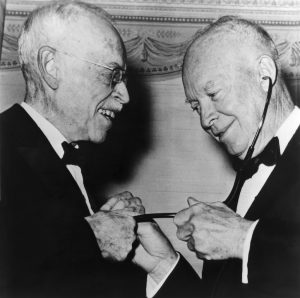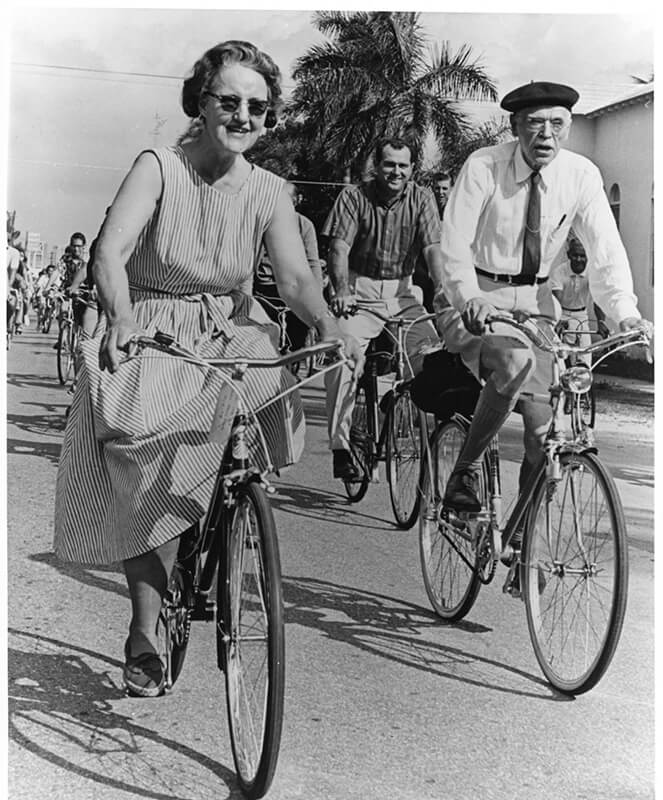Snaking up and down nearly 23 miles of Boston’s Charles River is a paved bike path well-known to the city’s cyclists.
Starting on its eastern end and traveling 16 miles, the largest section of the trail is named for a man that relatively few who travel it may know about, despite the early influence he had on making cycling the enormously popular activity it remains today.
For Dr. Paul Dudley White, the rise of the sport was the byproduct of what can be only described as his transformative impact on cardiology, electrocardiology, and preventative healthcare.
When he died, in 1973, the 87-year-old Bostonian was seen as one of the great figures in modern American medical history, described by Time magazine as ‘Dr. Cardiology,’ and President Richard Nixon as “a source of pride to physicians and laymen alike.”
The sentiments remain true when learning of his achievements today.

Despite his public and academic fame, White remained a doctor’s doctor who kept an office for practice until a year before he died, charged low patient fees, and biked to work.
A sharp, blue-eyed New Englander who “retained a precious quality of childlike enthusiasm”, he served as a medical officer in World War I, helped save the lives of two Presidents, and gave electrocardiograms to an elephant and a whale.
Perhaps most importantly, White convinced a generation how important it was to get regular exercise, leading to America’s first true bike boom in the 1960s and 1970s.
“Paul White set himself mountains – and had the strength to climb them,” Dr. David H. Spencer, Professor of Medicine at Boston’s Tufts University wrote, soon after White’s death in 1973.
“His scientific and humanitarian achievements are inextricably combined: devotion to humanity included men’s souls as well as their bodies; deduction to mankind never overlooked individual men.
“In cardiology, populated by prima donna of all ages, he was an ageless gentleman.”
The pull of the heart
Born the son of a family doctor in Roxbury, Boston in 1886, White was introduced to medicine at a young age, often travelling with his father to patient visits on a horse-drawn buggy.
White initially studied history at Harvard and the Massachusetts Institute of Technology (M.I.T), before graduating from Harvard Medical School in 1911.
After joining Massachusetts General Hospital (MGH), where he’d work for the next four decades, White first made his name after publishing an influential paper on coagulation with colleague Roger Lee.
In cardiology, populated by prima donna of all ages, he was an ageless gentleman.
Their research led to ‘White-Lee Coagulation Time’, a method for measuring clotting in tubes of body temperature blood that is still in use today.
In 1913, White studied cardiovascular physiology under Sir Thomas Lewis in London. Combined with his father and sister’s deaths from heart disease, some credit this moment as his great pivot to cardiology.
After serving as a medical officer in World War I, White threw himself into both medicine, and clinical research. While working at MGH, where he set up the cardiac department, he served as an instructor at Harvard Medical School.
Electrocardiology became a focus, as his passion for understanding the human heart deepened. In 1922, he helped found the American Heart Association.
By 1930, White, along with Harvard colleague Dr. Louis Wolff and London Hospital’s Sir John Parkinson, discovered Wolff-Parkinson-White Syndrome, a pre-excitation disorder causing an irregular disruption in the heart’s electrical rhythm.
Cementing his status as one of the world’s leading cardiologists, White published Heart Disease the following year.
The book, which emphasized the importance of establishing the ‘etiology, anatomy and functional status of each patient’, remained a standard reference for cardiologists for decades.
“Thus,” the New York Times wrote of White, who would become a clinical professor at Harvard, in their obituary, “Dr. White laid the foundation for today’s American cardiology.”
The importance of exercise
From the early 1920s, the benefits of regular exercise as preventative cardiac healthcare were clear to White.
He began promoting regular physical exercise despite prevailing medical opinion at the time that too much could damage the heart, with cycling personally favored.
Repeatedly, he advised Americans to eat sparingly, eschew cigarettes totally and exercise daily. He stressed that programmed exercise was essential, not bursts of summer tennis or weekend jogging.
“If we bear in mind that in his structure for a healthy life he included the control of hypertension and obesity, the opposition to cigarette smoking, and the moderate use of alcohol, we realize that he was a pioneer in the promotion of prevention and rehabilitation of heart patients,” Réne Favaloro wrote in an extensive 1999 paper into White’s impact on cardiology.
“Repeatedly,” the New York Times wrote in his obituary, “he advised Americans to eat sparingly, eschew cigarettes totally, and exercise daily.
“He stressed that programmed exercise was essential, not bursts of summer tennis or weekend jogging.”
That message and White’s public trajectory converged in 1955, when the Boston cardiologist helped save the life of President Dwight Eisenhower after he suffered a heart attack. He’d assisted then-Senator. Lyndon Baines Johnson recover from one, the same year.
White, who left his post at the head of MGH’s cardiac department in 1948 to help establish the National Heart Institute, was called in after White House doctors misdiagnosed an aneurysm. White instead recommended the president exercise, starting with cycling.
Though Eisenhower preferred golf to cycling, White’s message quickly spread amongst Americans. After building in popularity for the next decade, a bike boom was well underway by the late 1960s.
Up to 15.3 million bikes were bought in 1972, with numbers not rising that high again until the late 1990s (as late as 2009, the total number of bikes sold was lower than 1972).

“Dr. White did more for bicycles than any man living or dead,” Ray Caparros, the advertising manager of America’s biggest bike company, told the New York Times on August 15, 1971.
“I’d like to put everybody on bicycles, not once in a while but regularly as a routine,” White, who also favored dedicated cycle lanes, told a New York Heart Association conference in 1957.
The 1960s saw White travel often internationally, including ground-breaking visits to China and Russia, to spread a message about a more peaceful world, united by science and understanding.
A doctor’s doctor
For a man drawn to the mysteries and truths of the human heart, it is no surprise that he himself had a huge one himself.
“He was the type of doctor-warm and friendly-who would spend hours with a patient who had just suffered a coronary in an effort to convince him that he could live a long and useful life despite his illness,” a close associate told the Times.
“He inspired his patients to recover.”
We who are ‘médecins du coeur’ would also like to perform the miracle of healing the troubled world of today by a universal bond of spiritual brotherhood and medicine from the heart.
White always kept an outpatient office at MGH until he left, before establishing his own, on Back Bay’s Beacon St. A replica of his MGH office was later made into a permanent exhibit at the American Heart Association’s headquarters in Dallas.
Well-known for how little he charged patients, White asked no more than $25 (around $210 today) as late as 1963 (wealthier patients were asked to write a big check to a worthy charity).
Today, the Paul Dudley White Award is seen as prestigious recognition for Massachusetts physicians in cardiovascular or stroke care.
“We who are ‘médecins du coeur’ would also like to perform the miracle of healing the troubled world of today by a universal bond of spiritual brotherhood and medicine from the heart,” White once said.
Whether those who bike that stretch along the Charles River know it or not, they travel in the legacy of a man who always put the heart first.



